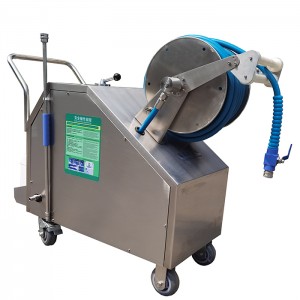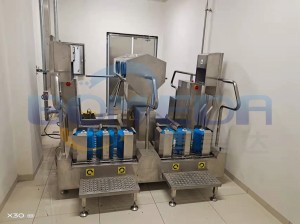Preface
Without hygienic control of the food production environment, food may become unsafe. In order to ensure that the company’s meat processing is carried out under good hygienic conditions and in conjunction with my country’s laws and health management standards, this procedure has been specially formulated.
1. Health management system for the area to be slaughtered
1.1 Personnel hygiene management
1.2 Workshop hygiene management
2. Slaughterhouse hygiene management system
2.1 Personnel hygiene management
2.1.1 Slaughter workshop personnel must undergo a health examination at least once a year. Those who pass the physical examination can only participate in work after obtaining a health license.
2.1.2 Slaughterhouse personnel should perform the “four diligences”, that is, wash ears, hands and nail clippings frequently, bathe and get haircuts frequently, change clothes frequently, and wash clothes frequently.
2.1.3 Slaughterhouse personnel are not allowed to enter the workshop wearing makeup, jewelry, earrings or other decorations.
2.1.4 When entering the workshop, work clothes, work shoes, hats and masks must be worn neatly.
2.1.5 Before starting work, the personnel in the slaughterhouse must wash their hands with cleaning fluid, disinfect their boots with 84% disinfectant, and then disinfect their boots.
2.1.6 Slaughter workshop personnel are not allowed to bring unstructured items and dirt unrelated to production into the workshop to engage in production.
2.1.7 If personnel in the slaughtering workshop leave their posts midway, they must be re-disinfected before entering the workshop before they can resume work.
2.1.8 It is strictly prohibited to leave the workshop to other places wearing work clothes, work shoes, hats and masks.
2.1.9 The clothing, hats and knives of the personnel in the slaughterhouse must be clean and disinfected before they can be worn and used.
2.2 Workshop hygiene management
2.2.1 Production tools must be rinsed before leaving get off work, and no dirt should be allowed to stick to them.
2.2.2 Floor drains in the production workshop must be kept unobstructed and must not accumulate feces, sediment, or meat residue, and must be cleaned thoroughly every day.
2.2.3 Workers must maintain hygiene in the work area during the production process.
2.2.4 After production, staff must clean the work area before leaving their posts.
2.2.5 Hygienists use high-pressure water guns to wash away dirt on the floor and equipment.
2.2.6 Hygienists use foam cleaning agent to flush the equipment and the floor (the turning box needs to be manually scrubbed with a cleaning ball).
2.2.7 Hygienists use high-pressure water guns to flush the equipment and foam cleaning agent on the floor.
2.2.8 Hygienists use high-pressure water guns to disinfect equipment and floors with 1:200 disinfectant (disinfection for at least 20 minutes).
2.2.9 Hygienists use high-pressure water guns for cleaning.
3. Separate workshop hygiene management system
3.1 Personnel hygiene management
3.1.1 Staff members must undergo a health examination at least once a year. Those who pass the physical examination can only participate in work after obtaining a health license.
3.1.2 Staff should perform the “four diligences”, that is, wash ears, hands and nails frequently, bathe and get haircuts frequently, change clothes frequently, and wash clothes frequently.
3.1.3 Staff members are not allowed to enter the workshop wearing makeup, jewelry, earrings and other decorations.
3.1.4 When entering the workshop, work clothes, work shoes, hats and masks must be worn neatly.
3.1.5 Before taking up work, staff must wash their hands with cleaning fluid and disinfect with 84% disinfectant, then enter the wind chime room, disinfect their boots, and pass through the boot washing machine before they can take up work.
3.1.6 Staff members are not allowed to enter the workshop with debris and dirt that are not related to production to engage in production.
3.1.7 Staff members who leave their posts midway must be re-disinfected before entering the workshop before they can resume work.
3.1.8 It is strictly prohibited to leave the workshop to other places wearing work clothes, work shoes, hats and masks.
3.1.9 The clothing of staff must be clean and disinfected before they can be worn.
3.1.10 It is strictly prohibited for staff to make loud noises and whisper during production operations.
3.1.11 Have a full-time health manager to supervise the health of production workers.
3.2 Workshop hygiene management
3.2.1 Ensure that the workshop is environmentally friendly, hygienic, clean and free of debris inside and outside the workshop, and insist on cleaning every day.
3.2.2 The four walls, doors and windows of the workshop are required to be clean, and the floor and ceiling should be kept clean and free of leaks.
3.2.3 During the production process, it is strictly prohibited to open doors and windows.
3.2.4 All equipment used in the production workshop should be kept clean and reasonably placed before and after production.
3.2.5 Production knives, pools, and workbenches must be cleaned and disinfected, and no rust or dirt should remain.
3.2.6 Workers must maintain hygiene in the work area during the production process.
3.2.7 After production, staff must clean the work area before leaving their posts.
3.2.8 It is strictly prohibited to store toxic and harmful substances and items unrelated to production in the workshop.
3.2.9 Smoking, eating and spitting are strictly prohibited in the workshop.
3.2.10 It is strictly forbidden for idle personnel to enter the workshop.
3.2.11 It is strictly prohibited for employees to play around and engage in matters unrelated to normal work.
3.2.12 Waste materials and garbage must be promptly cleaned up and left the workshop after production. It is strictly forbidden to leave garbage dead corners in the workshop.
3.2.14 Drainage ditches should be cleaned in time to ensure smooth flow of water and no waste residue and sewage sludge.
3.2.15 The waste of the day should be placed in the specified location in the specified place, so that the waste of the day can be processed and shipped out of the factory on the same day.
3.2.16 Various production equipment should be cleaned and disinfected regularly to ensure production quality.
3.3.1 The various standards of the production process are supervised by a dedicated person, and any behavior that does not meet the standards will be recorded and reported in detail.
3.3.2 Health management personnel shall supervise the cleaning and disinfection of production equipment, tools and containers before they can be used if they meet the health requirements.
3.3.3 Tools, utensils and containers used in each process should be distinguished and marked to prevent mutual contamination.
During the production process, it is strictly prohibited to open doors and windows.
3.2.4 All equipment used in the production workshop should be kept clean and reasonably placed before and after production.
3.2.5 Production knives, pools, and workbenches must be cleaned and disinfected, and no rust or dirt should remain.
3.2.6 Workers must maintain hygiene in the work area during the production process.
3.2.7 After production, staff must clean the work area before leaving their posts.
3.3.4 Each process in the production operation should strictly follow the first-in, first-out principle to avoid deterioration due to excessive backlog. During the processing, pay attention to: remove and avoid mixing in all debris. Processed waste materials and waste products must be placed in the in designated containers and clean them promptly.
3.3.5 No items unrelated to production are allowed to be stored at the production site.
3.3.6 The inspection of various hygienic indicators of production water should comply with national water standards
3.4 Packaging hygiene management system in divided workshops
3.4.1 The production department is responsible for the maintenance and cleaning of product packaging and packaging workshops, cold storage, and packaging material rooms;
3.4.2 The production department is responsible for the daily maintenance and upkeep of cold storage facilities.
4. Packaging workshop hygiene management system
4.1 Personnel hygiene
4.1.1 Personnel entering the packaging room must wear work clothes, packaging shoes, hats and masks.
4.1.2 Before working in the production workshop, workers in the production workshop must wash their hands with cleaning fluid, disinfect with 84% disinfectant, enter the wind chime room, disinfect their boots, and pass through the boot washing machine before they can work.
4.2 Workshop hygiene management
4.2.1 Keep the floor clean, clean and free of dust, dirt and debris.
4.2.2 The ceiling should be kept clean and tidy, with no hanging spider webs and no water leaks.
4.2.3 The packaging room requires clean doors and windows on all sides, no dust, and no stored waste. ,
4.2.4 Stack various packaged finished products in a reasonable and orderly manner and put them into storage in a timely manner to prevent accumulation.
5. Hygiene management system for acid discharge room
5.1 Personnel hygiene management
5.2 Workshop hygiene management
6. Hygiene management system for product warehouses and refrigerated fresh-keeping warehouses
6.1 Personnel hygiene management
6.1.1 Personnel entering the warehouse must wear work clothes, shoes, hats and masks.
6.1.2 Before taking up work, personnel must wash their hands with cleaning fluid, disinfect their boots with 84% disinfectant, and then disinfect their boots before taking up work.
6.1.3 Packaging personnel are not allowed to wear makeup, jewelry, earrings, bracelets and other decorations to enter the warehouse to engage in work.
6.1.4 If you leave your post midway and re-enter the warehouse, you must be disinfected again before you can return to work.
6.2 Sanitation management of finished product warehouse
6.2.1 The warehouse floor should be kept clean, so that there is no dust on the ground and no spider webs hanging on the roof.
6.2.2 After the food is put into storage, it should be stored separately according to the production date of the batch entered into the storage. Regular hygiene and quality inspections should be carried out on the stored food, quality forecasting should be done, and food with signs of spoilage should be dealt with in a timely manner.
6.2.3 When storing cold meat in the finished product warehouse, it must be stored in batches, first in, first out, and no extrusion allowed.
6.2.4 It is strictly prohibited to store toxic, harmful, radioactive substances and dangerous goods in the warehouse.
6.2.5 During the storage process of production materials and packaging, they should be protected against mildew and moisture in a timely manner to ensure that the production materials are dry and clean.
Post time: May-23-2024

